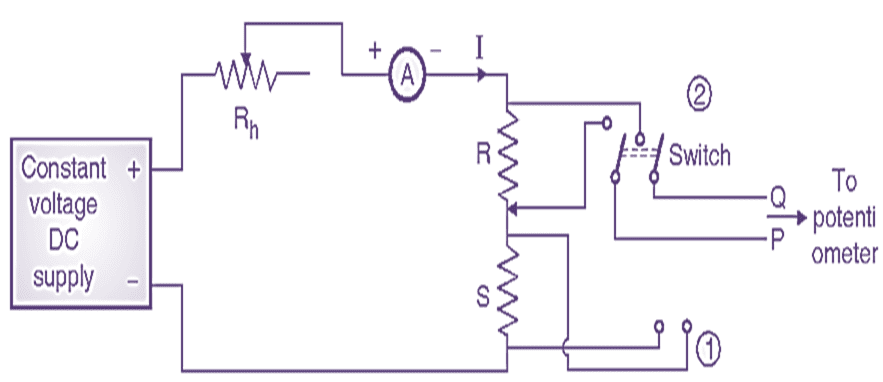In this topic, you study the definition and theory of low resistance.
The low resistance are those which are of about one ohm or even less. The resistance upto 1 ohm is known as low resistance. For example the measurement of armature resistance of an armature, series field winding, shunts, cable length and contact resistance etc.
Methods of Measuring Low Resistance
Low value resistance measurement. Following are the methods generally employed for the measurement of low value resistances:
- Ammeter-voltmeter method.
- Comparison method or Potentiometer method.
- Kelvin double wire bridge method.
- Ohmmeter method.
Potentiometer Method

Fig. 1: Circuit diagram for Measurement of low resistance.
The entire potentiometer circuit is not shown. The connections to potentiometer will be from points P and Q towards right side as shown. The circuit uses constant DC supply. The current can be varied by rheostat. The unknown resistance (R) is connected in series with standard resistance (S) of known value. The potentiometer is standardized as per usual procedure. The switch is put on position and a suitable current is adjusted by varying rheostat. This current I create a voltage drop across standard resistance S. This voltage can be measured by potentiometer.
Let the voltage measured by potentiometer be V1 volt. Thus
V1 = I.S …resistance of standard resistance
Now without disturbing the position of Rh i.e. maintaining same value of current I, switch is put on position 2. The potentiometer now gets connected across unknown resistance R. The current I flows through unknown resistance R and creates voltage drop across it. This voltage drop can be measured by potentiometer. Let the voltage measured by potentiometer be V2 volt. Thus
V2 = I.R …resistance of unknown resistance
Also, we can write
\[\frac{{{\text{V}}_{\text{1}}}}{{{\text{V}}_{\text{2}}}}=\frac{\text{I}\cdot \text{S}}{\text{I}\cdot \text{R}}\]
Thus,
\[\text{R}=\frac{{{\text{V}}_{\text{2}}}}{{{\text{V}}_{1}}}\cdot \text{S}\]
The RHS parameters are known. Thus unknown resistance R can be found.
Examples of Low Resistances
Practical Examples of Low Resistances used in Practice as
- Resistance of transformer winding,
- DC and AC machine armature winding,
- Ammeter coil,
- Wattmeter current coil,
- Earthing grid.